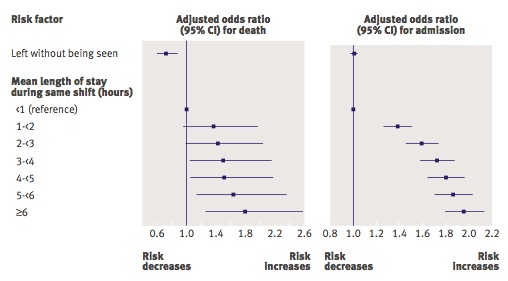There’s a lot of developing stuff out there that waiting times are bad, not just for patient experiences but also for clinical outcomes.
METHODS
These guys took a big Canadian database and looked at it to see what happened.
The key here is happened. It’s retrospective data from computer records, so beware; it’s good data but know its limiations.
- ED attendances who were either discharged or left without being seen
- stratified attendances by length of stay (the reasonable assumption here is that length of stay correlates with how busy the place is)
- defined adverse events as death or hospital admission with 7 days
RESULTS
- 14 million attendances (or so…)

I don’t really understand ORs, or at least I don’t know how to apply them so here’s some easier to understand numbers.
Comparing visits of <1 hr with >6 hrs:
- death changed from 0.1% to 0.15% in the high acuity groups and:
- 0.02% to 0.04% in the low acuity groups.
There were of course differences in terms of admissions too but they’re a wee bit more open to bias so I’ll not go into them.
INTERPRETATION
There are of course multiple ways to critique these kind of papers as to whether we can say anything “true” about such things but I don’t think they’re overwhelming problems.
So the dfference in terms of death isn’t huge by any means but it does seem to be there
Of course, this is fairly intuitive and obvious but it’s interesting to see the data behind it.
One of the reasons why it might be so difficult to show is that we do a damn good job – considering. The “considering” is the important part. When the place is crazy, we manage to do a decent job and it needs to be really bonkers for it to show in studies.
Though just because we cope under pressure doesn’t mean we should be happy with it.
